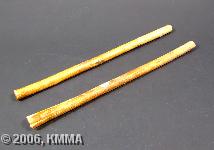
The rhythm stick is one of the simplest of idiophones. It can be composed of any material that has its own resonance. Apart from their everyday use as an object, utensils in particular are frequently integrated into a musical context and used to maintain or strengthen the rhythmic pulse. As regards sound, a clear and high pitch is preferred, supplementing the rest of the percussion, or to provide a rhythmical pulse for group singing. Generally the pattern is the same throughout the entire song and sometimes it is no more than a beat on each count.
Utensils such as bottles, cooking pots, and certainly agricultural materials such as metal hoes are very popular because of their clear resonance when struck with another hard object (hard wood, metal nails). The rhythm stick is not so much an instrument in which its maker can display his talents, but more a handy utensil that can be readily used to add a rhythmic pulse to the music.
This type of instrument is used in recordings of our sound archives made with the Congolese peoples mentioned hereafter where it appears with the following vernacular names:
Bekekeleke (Djonga), Bokoto (Pygmées), Ekekeleke (Hamba), Engeregesse (ekukuru) (Nande), Isuli (Boyela), Kakakasj (Lunda), Kipango temo (Pende), Lusengu (Sala Mpasu), Mahata ((Wa) Lese), Makeke (Boyela), Masa (Ng'bandi), Masuli (Boyela), Matakala (Nyari), Mes (Ndengese), Mikakala (Tshokwe), Mikokwelo (Luba, Lunda), Mishipo (Pende), Mokokwelo (Luba), Mokwata (Boyela, Kutu), Mukokwelo (mikokwelo) (Luba), Mukokwelo / Mikokwelo... (Ndembo), Mukwata (Ngombe), Nekekere (Mangbetu), Ntuku (Kutu), Tongwese (Boyela)
Discography:
© KMMA